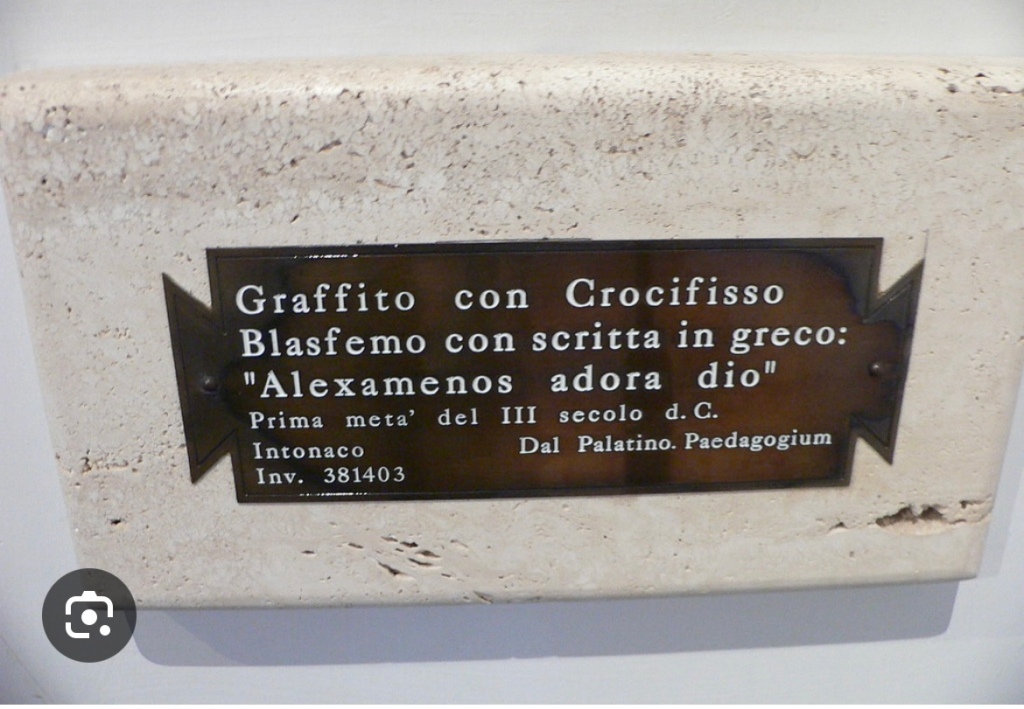Fernando Bermejo-Rubio used the Alexamenos graffiti on the cover of his book The invention of Jesus of Nazareth, History, fiction, historiography with the following caption-
Graphite of Alexamenos (2nd or 3rd century CE), discovered in the Paedagogium of the Palatine (Rome) in 1856. The inscription “ALEXAMENOS SEBETE THEON” means ” Alexamenos worships (his) god” or ” Alexamenos (says): worships God”.

In discussing the wider context of this graffiti Bermejo-Rubio goes on to say:
The mention of the crucifixion is found in the authentic letters of Paul, in Mark, in Flavius Josephus and in Tacitus, and is reflected in the graphite of Alexámeno del Palatino. … the fact that we have several sources and that among them there are some non-Christian ones increases the probability that they cannot be derived in their original form, from just one independent source. Of all the events related to the life of Jesus, his crucifixion presents the greatest number of testimonies.[1]
This is also one of the earliest known depictions of the crucifixion. It has a tau cross with hands of the crucified person were tied to the cross beam, and there was a bar to support the feet.[2] As noted by Campbell and Cilliers this was “a remarkable parody from early christianity called the Alexamenos graffito, or graffito blasfemo (ca. 238–244), still captures our imagination today. It was carved in the plaster of a wall near the Palatine hill in Rome and can be seen now in the Palatine Antiquarium Museum. It seems to have been created in the quarters of the imperial pageboys, a boarding school called Paedagogium. in the depiction, one of the boys, obviously a christian, is being mocked by another boy, or by a group of his schoolfellows, by means of parody.”[3] Next to the graffiti is another inscription: Alexamenos is faithful (Alexamenos fidelis). Whether Alexamenos wrote this himself is unknown.

The building that housed this school had been purchased by the Roman Emperor, Caligula, around 40CE and was later changed to a boarding school for Roman noble’s messenger boys. “Alexamenos received his education on the upper floor of a modest two-story building which was tucked among the imposing imperial architecture that crowds the southwest slope of Rome’s Palatine Hill. The Palatine was an exclusive neighborhood in the heart of the city, but even emperors needed space for service workers. … At some point in the second century, the upper story became a school. It was here that Alexamenos spent his mornings learning basic numeracy, reading, and writing.”[4]
In the graffiti we have a human with a head of a donkey crucified. Christianity was roundly derided in Rome at this time, and Christians were even accused of practicing Onolatry (donkey worship). It was Minucius Felix that had said, “I hear that they adore the head of an ass, that basest of creatures, consecrated by I know not what silly persuasion—a worthy and appropriate religion for such manners.” (Minucius Felix, Octavius IX). Tertullian defended the christian belief against the charge of a critic who carried around a picture directed against christians with the heading Onocoetes, which means “donkey priest.” The picture featured a man wearing a toga and the ears of a donkey with a book in hand and one leg ending in a hoof. (Tertullian, Apology, XVI).
The donkey became the standard metaphor for stupidity and foolishness in classical antiquity. Cicero, for instance, calls Calpurnius Piso a donkey, someone not capable of being taught letters, and not in need of words, but rather fists or sticks. ( Cicero, In Pisonem 73.37) Juvenal even talks about a stupid person as a two-legged donkey. (Juvenal, Satura 9.92).[5]
As Candida Moss observed “Alexamenos, the caricaturist, and his classmates were not freeborn schoolchildren; they were enslaved members of the imperial family. Family might seem a strange kind of word to use for coerced individuals, but the family (familia) was the social building block of the Roman Empire. The imperial family (or household) incorporated enslaved people and freedmen who were unlikely to have biological ties to the emperor (even if this was a possibility). The room where the students were shaped into copyists, bookkeepers, and secretaries was in truth more a workshop than a school. But like any place of learning, it gave its students brief moments to discuss athletics, create their own sharp hierarchies of status and popularity, and make cruel jokes as only children can.”[6]
The cutting cruelty is not lost on Candida Moss as she shows that crucifixion was all too real for the “enslaved people. Thus, for Alexamenos—as for all enslaved workers in Rome—the cross was both a symbol and a concrete possibility.”[7]

M. David Litwa also discusses the possibility that the image may also have been an image of Seth. Litwa says Seth was frequently described as having the form or skin of a donkey. (Plutarch, Isis-Osiris 362f-363b). Throughout chapter 2 Litwa explains hellenised Egyptians started describing Yahweh as having the head of an Ass. Variants of a story Antiochus IV discovering the head of an ass at the Temple in 167BC started circulating fusing the form of Seth and Yahweh. (Example: Damocritus, On the Jews; Suetonius, Aug. 40.5. “Jews worshipping donkeys”). Litwa explains the polemic of Yahweh fusing the donkey form of Seth could have been transferred onto Yahweh’s son Jesus in the Alexamenos graffiti.[8]
[1] Fernando Bermejo-Rubio, The invention of Jesus of Nazareth History, fiction, historiography, Siglo XXI / Serie Historia, 2018), p.109.
[2] Everett Ferguson, Backgrounds of Early Christianity, 3rd ed. (Grand Rapids: Eerdmans, 2003), pp.596–97.
[3] Charles L. Campbell and Johann H. Cilliers, Preaching Fools, The gospel as a rhetoric of Folly, (Waco Texas: Baylor University Press, 2012), p.2
[4] Candida Moss, God’s Ghostwriters, Enslaved Christians and the making of the Bible, (London: HarperCollins, 2024), p.23.
[5] Campbell and Cilliers, Preaching Fools, p.4
[6] Moss, God’s Ghostwriters, p.24-5.
[7] Moss, God’s Ghostwriters, p.27
[8] L. David Litwa, The Evil Creator, Origins of an Early Christian Idea, (Oxford, 2021), ch.2.
hey that Richard carrier guy made a weak response to you will you respond to him https://www.richardcarrier.info/archives/27782
LikeLike
I have a notch on my baseball bat, 😀, I know I’ve made it when Carrier polemics come my way. The thing is not to respond to him cos all he is, is polemics. Like all the ex nihilo guys his arguments only work off of the textus receptus and don’t work on the earlier form of the TF.
We know Origen digressed onto the TF taking Cels. 1.47 and Cels. 1.48 together. The only argument Carrier made is that Origen digressed- (which basically means nothing)
As I wrote before:
For the Jews do not connect John with Jesus, nor the punishment of John with that of Christ’ (Cels. 1.48). In Antiquities it does not connect the Baptist movement with the Jesus movement. Also in Antiquities, the execution of John (beheading) is different from the execution of Jesus (crucifixion). Therefore, these two passages taken together (Cels. 1.47, 48) show that Origen used Antiquities in his fights with Celsus- Model Reconstruction p.120.
LikeLike
your new paper come out will respond to Ken Olson and carrier
LikeLike
Contra Olson, Carrier and Hansen, I will expose a pre Eusebian strata in the Testimonium Flavianum. The variants all show an earlier form of the TF, in my paper I show some witnesses go back before Eusebius tampering. Many arguments of mine will knock out Olson and Hansen (Carrier being a lightweight when it comes to the TF has no real arguments outside of Olson), I will also show Hopper only tested the textus receptus and none of his arguments work on the earlier forms of the TF. My paper will also show an earlier form of the Baptist passage as the Baptism was meddled with. Lastly I will show what the TF originally looked like- so really looking forward to the publication of my paper.
LikeLike
is it okay if I talk to you about something I have something to admit I’m not an atheist I’m a Christian I struggle with my faith that’s why I wanted to ask you about the Pauline evidence my life isn’t that good my mother is sick she’s in a wheelchair can barely move and I don’t have a job or anything really going for me in life I’m depressed
LikeLike